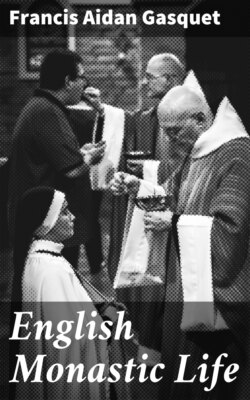Читать книгу English Monastic Life - Francis Aidan Gasquet - Страница 15
На сайте Литреса книга снята с продажи.
8. THE GUEST-HOUSE
ОглавлениеTable of Contents
The guest-house (hostellary, hostry, etc.) was a necessary part of every great religious house. It was presided over by a senior monk, whose duty it was to keep the hall and chambers ready for the reception of guests, and to be ever prepared to receive those who came to ask for hospitality. Naturally the guest-house was situated where it would be least likely to interfere with the privacy of the monastery. The guest-place at Canterbury was of great size, measuring forty feet broad by a hundred and fifty feet long. The main building was a big hall, resembling a church with columns, having on each side bedrooms or cubicles leading out of it. In the thirteenth century John de Hertford, abbot of St. Alban’s, built a noble hall for the use of guests frequenting his abbey, with an inner parlour having a fireplace in it, and many chambers arranged for the use of various kinds of guests. It had also a pro-aula, or reception-room, in which the guest-master first received the pilgrim or traveller, before conducting him to the church, or arranging for a reception corresponding to his rank and position.
In the greater monastic establishments there were frequently several places for the reception of guests. The abbot, or superior, had rooms to accommodate distinguished or honoured guests and benefactors of the establishment. The cellarer’s department, too, frequently had to entertain merchants and others who came upon business of the house: a third shelter was provided near the gate of the monastery for the poorer folk, and a fourth for the monks of other religious houses, who had their meals in the common refectory, and joined in many of the exercises of the community.
The Rites of Durham thus describes the guest-house which the author remembered in the great cathedral monastery of the North:—
